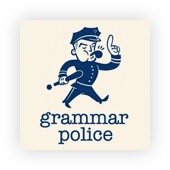Comma Splices
Advice on Tackling One of Writing’s Most Pesky Errors
Introduction

Honestly, comma splices are probably the most common errors that I correct on student papers. In addition to being all-too-common, they are considered by most writing instructors to be major errors. So you want to avoid them at all costs.
But perhaps you’re still wondering . . .
What Are Comma Splices?
Comma splices occur when you join two independent clauses (two sentences) with just a comma.
Independent Clause + Comma + Independent Clause = Comma Splice
Independent Clause + Comma + Independent Clause = Comma Splice
The length of the sentence is irrelevant.
All of the following are comma splices:
All of the following are comma splices:
- I played, you worked.
- The dog ran, the cat jumped.
- I decided that because I was hungry I would go to Cafe Brazil to get one of their wonderful omelettes for breakfast, while I was there I saw my old friend Tony.
- Batman drove, Superman flew.
- My dog is the best dog ever, he agrees with me, the cat disagrees.
- I wanted to major in engineering, however, I decided being an English major was the best option.
- I went to the grocery store just to buy some milk, unfortunately three hours and $400 later I was finally done with my grocery shopping.
Why Do They Matter?
- It’s a sentence boundary issue. Sentences are the smallest “units of meaning” in English, so you need to make it clear where they begin and end.
- Commas are considered “weak” punctuation, since they cannot express relationships between independent clauses. They also lack the power to end an independent clause like a semicolon or period.
- Having an excessive amount of comma splices affects one’s ethos as a writer. It gives the impression that a writer doesn’t understand where sentences begin and end. And that’s not good!
How Do I Fix Them?
- Use a period
- Add a semicolon
- Insert a proper coordinating conjunction (“FANBOYS”)
- Subordinate one clause to the other
- The Batmobile lost its wheel, the Joker got away.
- The Batmobile lost its wheel, and the Joker got away.
- The Batmobile lost its wheel, the Joker got away.
- While the Batmobile lost its wheel, the Joker got away.
How Do I Find Them?
- Print out your papers (yes, on actual paper). It’s simply far more effective to proofread the printed page than a computer, tablet, or phone screen.
- Mark every single comma with a “loud” highlighter (e.g. bright pink, neon yellow). Of course, not every comma will be a comma splice, but this method will help you check and correct other punctuation errors as well.
- With every usage, ask yourself - is this a comma splice? If so, how can I fix it?
- Double check your usage of conjunctive adverbs as well.
Conjunctive adverbs connect independent clauses and show a specific kind of relationship between the two clauses (e.g. cause and effect, sequence, contrast). Common conjunctive adverbs include consequently, however, therefore, nonetheless, and nevertheless.
Conjunctive adverbs cannot be used with just a comma to join two independent clauses. They must be used with periods or semicolons. Otherwise, a comma splice is born.
Conjunctive adverbs cannot be used with just a comma to join two independent clauses. They must be used with periods or semicolons. Otherwise, a comma splice is born.
Misuse of semicolons is another serious error and one that often creates sentence fragments. So I recommend that you use one color to highlight commas and another to highlight semicolons. Check the commas for comma splices; check the semicolons for fragment creation. Yes, it’s a little extra work, but the payoff is worth it.